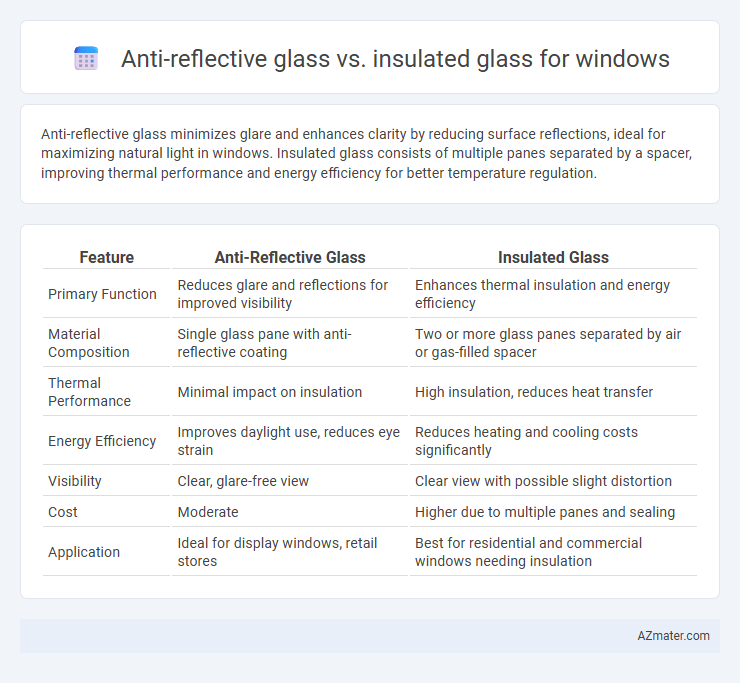Anti-reflective glass minimizes glare and enhances clarity by reducing surface reflections, ideal for maximizing natural light in windows. Insulated glass consists of multiple panes separated by a spacer, improving thermal performance and energy efficiency for better temperature regulation.
Table of Comparison
| Feature | Anti-Reflective Glass | Insulated Glass |
|---|---|---|
| Primary Function | Reduces glare and reflections for improved visibility | Enhances thermal insulation and energy efficiency |
| Material Composition | Single glass pane with anti-reflective coating | Two or more glass panes separated by air or gas-filled spacer |
| Thermal Performance | Minimal impact on insulation | High insulation, reduces heat transfer |
| Energy Efficiency | Improves daylight use, reduces eye strain | Reduces heating and cooling costs significantly |
| Visibility | Clear, glare-free view | Clear view with possible slight distortion |
| Cost | Moderate | Higher due to multiple panes and sealing |
| Application | Ideal for display windows, retail stores | Best for residential and commercial windows needing insulation |
Introduction to Anti-Reflective and Insulated Glass
Anti-reflective glass minimizes glare and enhances light transmission by using specialized coatings to reduce reflections, ideal for improving visibility in windows exposed to direct sunlight. Insulated glass consists of two or more glass panes separated by a sealed air or gas-filled space, providing superior thermal insulation and energy efficiency for windows in both residential and commercial buildings. These technologies serve different functional needs: anti-reflective glass optimizes clarity and aesthetics, while insulated glass prioritizes temperature control and noise reduction.
How Anti-Reflective Glass Works
Anti-reflective glass reduces surface reflection by using multiple thin layers of dielectric coatings that cause destructive interference of reflected light waves, enhancing transparency and visibility. This technology minimizes glare and improves natural light transmission, making it ideal for windows in environments with high sunlight exposure. Compared to insulated glass, which primarily offers thermal insulation through air or gas-filled gaps, anti-reflective glass focuses on optical clarity and visual comfort.
How Insulated Glass Works
Insulated glass consists of two or more glass panes separated by a sealed air or gas-filled space, creating a thermal barrier that reduces heat transfer and enhances energy efficiency in windows. This air gap acts as an insulating layer, minimizing heat loss in winter and heat gain in summer, while also lowering condensation and noise transmission. In comparison, anti-reflective glass primarily reduces glare and improves visibility but does not provide the same level of thermal insulation or energy savings as insulated glass.
Key Differences Between Anti-Reflective and Insulated Glass
Anti-reflective glass minimizes surface glare and improves visibility by reducing reflections, making it ideal for display windows and high-clarity applications. Insulated glass consists of two or more glass panes separated by an air or gas-filled space, offering superior thermal performance and energy efficiency for windows. Key differences include anti-reflective glass's focus on optical clarity versus insulated glass's emphasis on insulation and temperature regulation.
Energy Efficiency Comparison
Anti-reflective glass reduces glare and improves natural light transmission but offers limited insulation properties, making it less effective for energy savings. Insulated glass, typically double or triple-pane with gas fills like argon, significantly enhances thermal performance by minimizing heat transfer and reducing heating and cooling costs. For optimal energy efficiency, insulated glass outperforms anti-reflective glass in maintaining indoor temperature stability and lowering overall energy consumption.
Light Transmission and Visibility
Anti-reflective glass significantly enhances light transmission by minimizing surface reflections, resulting in clearer visibility and a brighter indoor environment. Insulated glass, composed of two or more panes separated by a spacer, provides superior thermal insulation but may slightly reduce light transmission due to multiple layers. Choosing anti-reflective glass improves daylight clarity, while insulated glass balances visibility with energy efficiency and temperature control.
Performance in Noise Reduction
Anti-reflective glass primarily enhances light transmission and reduces glare but offers limited noise reduction capabilities compared to insulated glass. Insulated glass, typically composed of two or more panes separated by a sealed air or gas-filled space, significantly improves soundproofing by dampening external noise through its multi-layered structure. Performance in noise reduction depends on the thickness of the glass and the width of the insulating gap, with insulated glass outperforming anti-reflective glass for quieter indoor environments.
Durability and Maintenance
Anti-reflective glass offers enhanced durability due to its specialized coating that resists scratches and minimizes glare, requiring minimal maintenance to retain clarity. Insulated glass features multiple panes separated by a sealed air or gas space, providing robust thermal resistance and structural strength, but necessitates periodic inspection to prevent seal failure and moisture buildup. Both types contribute to window longevity, yet anti-reflective glass demands less frequent upkeep compared to insulated glass units.
Cost Considerations
Anti-reflective glass generally incurs higher upfront costs due to specialized coatings that enhance light transmission and reduce glare, making it ideal for aesthetic and visibility-focused applications. Insulated glass, composed of two or more glass panes separated by a spacer and sealed to create an air or gas-filled cavity, offers superior energy efficiency and noise reduction but often comes at a moderate price increase compared to standard glass. Budget constraints typically steer homeowners towards insulated glass for cost-effective energy savings, while anti-reflective glass is favored in settings prioritizing visual clarity despite its premium pricing.
Choosing the Right Glass for Your Windows
Anti-reflective glass minimizes glare and enhances visual clarity by reducing surface reflections, making it ideal for windows in areas with intense sunlight or where clear views are essential. Insulated glass, composed of two or more glass panes separated by a gas-filled space, significantly improves thermal performance and energy efficiency by reducing heat transfer and condensation. Choosing the right glass depends on prioritizing either glare reduction or energy savings, with factors like climate, window orientation, and comfort needs guiding the optimal selection.

Infographic: Anti-reflective glass vs Insulated glass for Window
 azmater.com
azmater.com